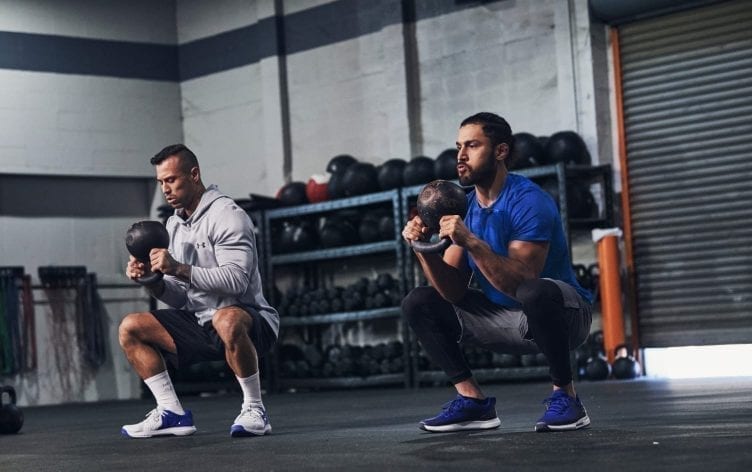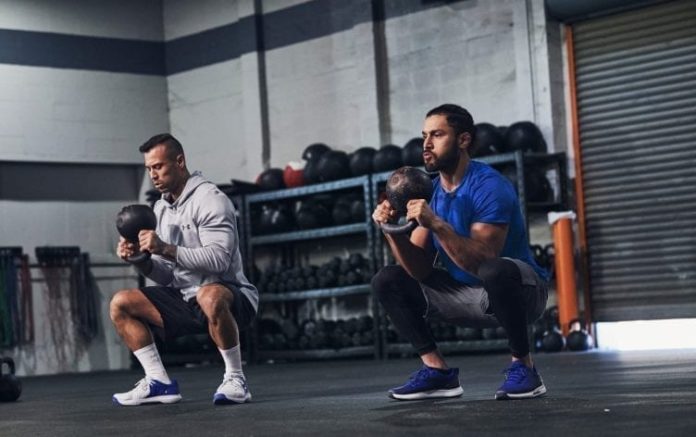
Though fitness trends come and go (alas, Jazzercise has been replaced by kettlebells and Peloton), regular movement remains a critically important contributor to our health and well-being.
Recently, the rise of functional fitness has challenged exercisers and gym-goers everywhere to rethink how — and why — they work out. Though this mega fitness trend seems to be here to stay, what exactly is it?
WHAT ‘FUNCTIONAL FITNESS’ ACTUALLY MEANS
Though ‘functional fitness’ is a broad term, it really refers to “training or working out in a way that helps you perform better in life or in sports or activities you participate in,” explains Grayson Wickham, DPT, a certified strength and conditioning specialist and founder of the digital mobility platform Movement Vault.
The basic idea: What you do in the gym directly benefits your ability to do whatever it is you do outside of the gym. “This approach to working out utilizes a large variety of exercises that focus on movement patterns you perform in other areas of your life,” Wickham says.
That means functional fitness is about so much more than losing weight or having biceps that bulge out of your T-shirt. It’s about becoming a more capable human being.
THE BENEFITS OF FUNCTIONAL FITNESS
While bodybuilding-style workouts, for example, focus on movements that grow certain muscles so you can achieve a certain physique, functional fitness workouts focus on movements that help you do things outside of the gym. “How many times per day do you bend over to pick something up off of the ground,” asks Wickham. The goal of functional fitness is to make real-world movements like that easier.
“A functional fitness-focused program will help you become stronger and faster, move better and improve your coordination,” Wickham says.
By getting as much of your body involved as possible (typically moving multiple joints at once), functional movements help your body become stronger and more resilient throughout all planes of motion — meaning you can twist to grab your squirming toddler, pull that heavy box off the top shelf and keep up with your dog in the backyard more easily. It also means you’re less likely to get injured doing everyday things, says Wickham.
Not to mention, since functional exercise typically demands more work of more muscles, it often helps you build more muscle mass and greater strength — and yes, burn more calories — than less functional workouts.
WHY WE NEED FUNCTIONAL FITNESS
“We have been evolving for thousands of years and have always had to move in order to survive,” says Wickham. Throughout our history, we’ve had to climb things, chase things, lift things, pull things and build things.
“Today, though, technology has made life very physically easy for us, and does a lot of the moving and lifting for us,” Wickham says. The result: We live sedentary lives, have tighter muscles and joints, move poorly and are generally weaker and less resilient. Ouch.
So if we’re only spending an hour moving every day (versus the constant movement that used to pepper our days), it’s more important than ever that our hour of movement makes us a stronger, healthier, more capable human being. In fact, it’s crucial for feeling better (mentally and physically), decreasing pain, preventing injury and living a long, healthy life, Wickham argues.
WHAT FUNCTIONAL FITNESS LOOKS LIKE IN (AND OUT) OF THE GYM
Yes, functional fitness can include a huge variety of exercises and movements. However, it generally involves exercises that use multiple joints and muscles (Think: your legs and your upper body) in multiple planes of motion (Think: side-to-side and rotational), says Wickham.
In addition to getting all the muscles and joints involved in all the directions, a good functional fitness workout program also stimulates the body in multiple ways, Wickham says. You’ll want to include heavy strength work, as well as high-intensity and cardiovascular endurance work.
That means you might build strength with heavy barbell or dumbbell deadlifts, kick up the intensity with box jumps, and develop endurance with jogging or sled pushes.
Isolation exercises popular in bodybuilding — like biceps curls — often aren’t considered functional, Wickham says. After all, they only involve one joint. However, “flexing the elbow, which is essentially a biceps curl, is how we pick things up,” Wickham says. So, even isolation exercises can have a place in a functional fitness program, as long as your main focus is on moving better — not just looking a certain way.
THE BOTTOM LINE
Ultimately, the functional fitness plan that’s best for you depends on your current fitness, activity level, injuries, age and goals. A certified personal trainer can help determine what types of movements will most benefit your day-to-day life — whether you want to hike mountains on an upcoming trip with ease, or be able to carry your 5-year-old around all day without your arms giving out.







